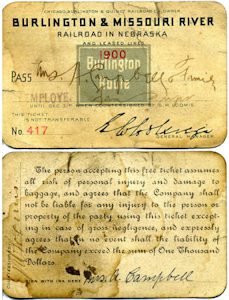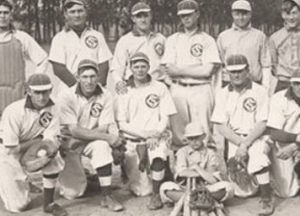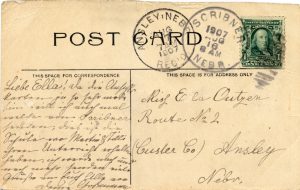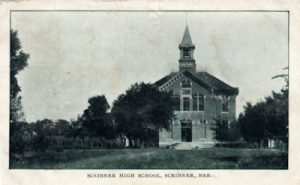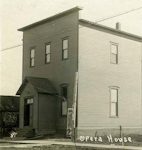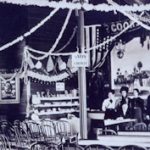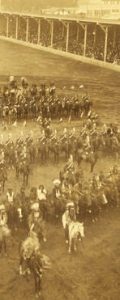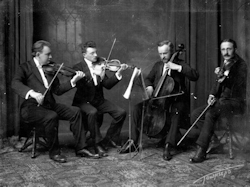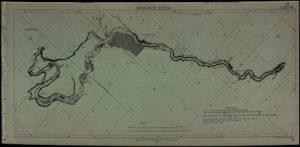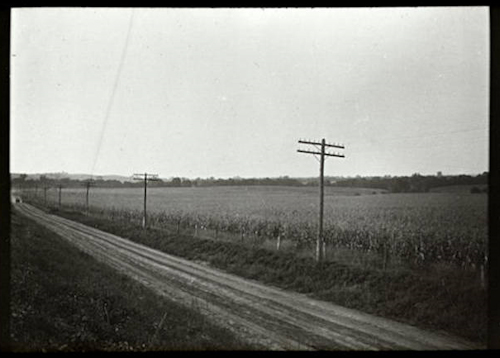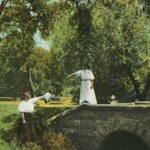Search the Blog
Categories
- Books & Reading
- Broadband Buzz
- Census
- Education & Training
- Friday Reads
- General
- Grants
- Information Resources
- Library Management
- Nebraska Center for the Book
- Nebraska Libraries on the Web
- Nebraska Memories
- Now hiring @ your library
- Preservation
- Pretty Sweet Tech
- Programming
- Public Library Boards of Trustees
- Public Relations
- Talking Book & Braille Service (TBBS)
- Technology
- Uncategorized
- What's Up Doc / Govdocs
- Youth Services
Archives
Subscribe
Author Archives: Allison Badger
Friday Reads: Little Women by Louisa May Alcott
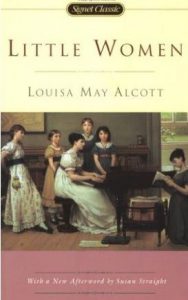 Set during the Civil War and following years, Louisa May Alcott’s Little Women tells the story of four remarkable sisters: Meg, Jo, Beth and Amy. When we first meet them, they, and their mother, struggle to make ends meet while their father serves as a minster in the Union army. Despite their lack of material wealth, the Marches share what little they have with their poorer neighbors. This charitable act catches the eye of their wealthy neighbor James Laurence and his grandson, Laurie. Over the course of the novel, Laurie grows close to the sisters, particularly Jo.
Set during the Civil War and following years, Louisa May Alcott’s Little Women tells the story of four remarkable sisters: Meg, Jo, Beth and Amy. When we first meet them, they, and their mother, struggle to make ends meet while their father serves as a minster in the Union army. Despite their lack of material wealth, the Marches share what little they have with their poorer neighbors. This charitable act catches the eye of their wealthy neighbor James Laurence and his grandson, Laurie. Over the course of the novel, Laurie grows close to the sisters, particularly Jo.
In writing Little Women, Alcott drew heavily from her childhood in Concord, Massachusetts, the book’s principal setting. Like the Marches, the Alcott family struggled financially at times. The Alcott family also followed American transcendentalism or the belief that people and nature are inherently good. On numerous occasions, Alcott’s characters express a belief in transcendentalism. Even when they’re at their lowest, they choose to see the good in others. Additionally, the character of Jo is said to be drawn from Alcott. They not only shared numerous personality traits, but both chose to pursue literary careers at a time when middle class women did not work outside of the home.
While Little Women takes place during the late-nineteenth century, the story continues to strike a chord with today’s readers. Like modern girls, the March sisters fall in love, encounter envy, struggle to fit in with wealthy friends, fight with siblings, and find their way in the world. We rejoice at Meg’s marriage, laugh at Jo’s antics, and weep when they lose loved ones because these are universal experiences we all go through at some point. In other words, we see ourselves in the Marches.
Alcott, Louisa May. Little Women. New York: Signet Classics, 2004. Originally published 1868.
Posted in Books & Reading
Tagged "Little Women", #GreatReadPBS, Friday Reads, Louisa May Alcott, The Great American Read
1 Comment
Friday Reads: Tana French
 Reading a Tana French novel is like taking a trip to Dublin, Ireland. Like Maeve Binchy, French manages to capture not only the spirit of this city, but its people as well. While French’s novels focus on detectives from Dublin’s murder squad, these are not your classic police procedural mysteries. Rather, they focus on an ever-changing group of wonderfully complicated characters, full of contradictions, whose personal lives are delightfully messy. The victims, themselves, are equally interesting as well. Like the detectives who investigate their murders, their lives are complex and marked with many question marks. Rarely does the story travel in a straight line, but rather zigs and zags until the final page.
Reading a Tana French novel is like taking a trip to Dublin, Ireland. Like Maeve Binchy, French manages to capture not only the spirit of this city, but its people as well. While French’s novels focus on detectives from Dublin’s murder squad, these are not your classic police procedural mysteries. Rather, they focus on an ever-changing group of wonderfully complicated characters, full of contradictions, whose personal lives are delightfully messy. The victims, themselves, are equally interesting as well. Like the detectives who investigate their murders, their lives are complex and marked with many question marks. Rarely does the story travel in a straight line, but rather zigs and zags until the final page.
Currently, there are six novels in French’s Dublin Murder Squad series: In the Woods (2007), The Likeness (2008), Faithful Place (2010), Broken Harbor (2012), The Secret Place (2014) and The Trespasser (2016). All take place in Dublin, or the surrounding area. All take place within a short period, usually no more than over the course of a few weeks.
Unlike other series, such as the Kay Scarpetta books by Patricia Cornwell or Elizabeth  George’s Inspector Lynley novels, French focuses each book on a different character. Some characters, such as Frank Mackey and Mick “Scorcher” Kennedy appear in several books. Others, like Rob Ryan from In the Woods, vanish as soon as their story concludes. That said, each title can be read in no particular order without feeling as though you’ve missed something along the way.
George’s Inspector Lynley novels, French focuses each book on a different character. Some characters, such as Frank Mackey and Mick “Scorcher” Kennedy appear in several books. Others, like Rob Ryan from In the Woods, vanish as soon as their story concludes. That said, each title can be read in no particular order without feeling as though you’ve missed something along the way.
Ultimately, French spins terrific tales of suspense and intrigue. Her stories are not always pretty. Often, in their rush to solve a murder, French’s characters reveal their deepest and darkest secrets. Instead of making them unlikeable, it makes them relatable. After all, we all have our secrets.
Friday Reads: Death and the Virgin Queen: Elizabeth I and the Dark Scandal That Rocked the Throne
 The circumstances surrounding Amy Robsart’s death in 1560 have haunted historians for more than 450 years. Was she pushed down the stairs or did she trip and fall? Was she poisoned and her body positioned to look like an accident? Death and the Virgin Queen: Elizabeth I and the Dark Scandal That Rocked the Throne by Chris Skidmore attempts to answer these questions. Skidmore argues that his reexamination contemporary records, as well as the long-long coroner’s report of Amy death and a contemporaneous journal kept by an unknown individual, sheds new light on this enduring mystery.
The circumstances surrounding Amy Robsart’s death in 1560 have haunted historians for more than 450 years. Was she pushed down the stairs or did she trip and fall? Was she poisoned and her body positioned to look like an accident? Death and the Virgin Queen: Elizabeth I and the Dark Scandal That Rocked the Throne by Chris Skidmore attempts to answer these questions. Skidmore argues that his reexamination contemporary records, as well as the long-long coroner’s report of Amy death and a contemporaneous journal kept by an unknown individual, sheds new light on this enduring mystery.
Robsart’s passing would have attracted little attention if she had not been the wife of Elizabeth I’s favorite courtier Robert Dudley. In the months and years leading to Robsart’s fatal fall, Dudley rarely left Elizabeth’s side. In fact, rumors swirled not only through the English court, but through other European courts as well, that Elizabeth and Dudley were engaged in a passionate affair. While Dudley attended to England’s queen, Robsart lived a quiet, but transient life – staying with friends and family because the Dudleys lacked a permanent home. Dudley rarely visited Robsart, but made sure she never lacked for funds and other necessities.
Why the mystery then? Skidmore suggests that Robsart’s death was long expected by members of Elizabeth’s court. Prior to Amy’s death, rumors had circulated that she was in poor health and/or she was being poisoned. Skidmore cites several instances where courtiers and foreign ambassadors speculated that once Dudley was free of his wife, he would marry Elizabeth I. The circumstances surrounding Amy’s sudden passing become murkier when Skidmore reveals that Elizabeth mentioned Robsart’s death to the Spanish ambassador prior to it becoming public knowledge.
Skidmore focuses his examination primarily on Dudley – his motives and how he might have carried out this deed. Despite the introduction of new documents and a reinterpretation of existing facts, Skidmore fails to provide additional insight into Robsart’s death. The basic facts are unchanged: Robsart’s body was found at the bottom of a short flight of stairs. She encouraged the household to attend a nearby fair, leaving the house largely empty. Perhaps if Skidmore had looked at suspects beyond Robert Dudley, he would have brought something new to the table. For example, other courtiers such as Dudley’s enemy Sir William Cecil could have arranged for Robsart’s death in order to tarnish Dudley’s reputation. However, Skidmore successfully demonstrates that Robsart’s mysterious death colored people’s treatment of Dudley, as well as destroyed any chance of marrying Elizabeth. Ultimately, too much time has passed and too little evidence has survived for this mystery to be solved.
Friday Reads: Mansfield Park by Jane Austen
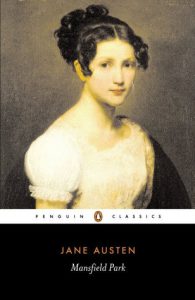 Until recently, I rated Mansfield Park as my second least favorite Jane Austen novel. For the record, Northanger Abbey is my least favorite of Austen’s completed works. I did not care for Mansfield Park because of Austen’s depiction of Fanny Price. Fanny is a poor relation taken in by her wealthy uncle, Sir Thomas Bertram. When Fanny first arrives at Mansfield Park, she is a scared and lonely ten year old. In many ways, she remains a frightened child, prone to low spirits and headaches. I disliked Fanny because she rarely offers an opinion or speaks her mind, is often judgmental and bursts into tears much too often for my liking.
Until recently, I rated Mansfield Park as my second least favorite Jane Austen novel. For the record, Northanger Abbey is my least favorite of Austen’s completed works. I did not care for Mansfield Park because of Austen’s depiction of Fanny Price. Fanny is a poor relation taken in by her wealthy uncle, Sir Thomas Bertram. When Fanny first arrives at Mansfield Park, she is a scared and lonely ten year old. In many ways, she remains a frightened child, prone to low spirits and headaches. I disliked Fanny because she rarely offers an opinion or speaks her mind, is often judgmental and bursts into tears much too often for my liking.
Throughout the novel, we watch Fanny’s family ignore her needs while assuming they know what’s best for her. Unlike many of her other characters, Austen allows Fanny to seethe with frustration, resentment and disappointment as they place their well-being before hers. While outwardly agreeable and meek, Fanny reveals she can be neither when refusing to marry the well-off Henry Crawford. Later the rightness of her decision is revealed when Crawford seduces and runs off with Fanny’s married cousin, Maria.
The last time I read Mansfield Park, I discovered there was more to Fanny Price than tears and moral rectitude. I still found her annoying, but I realized that Fanny enjoys the small pleasures that many of us take for granted. Walking with her cousin Edmund or listening to her brother’s stories fill Fanny with joy – she genuinely enjoys these moments. Her brother William’s impending visit, an outing to a neighboring estate and attending a ball thrown in her honor; all reduce her to tears. Yes, she is overwrought. I can’t imagine being so caught up in the moment that I weep with happiness. Yet, there is something appealing about Fanny’s willingness to embrace each and every moment life gives her. Perhaps this is Jane Austen’s greatest lesson.
Austen, Jane. Mansfield Park. New York: Penguin Classics, 2003.
Preserving the Past
Your library has boxes and boxes of old photographs, documents and who knows what else. They’re old. They’re dusty. Some are labeled. Some aren’t. They’ve been in those boxes for years. You don’t know what to do with them. You’d like find a way to preserve them, preferably in digital form, but this type of project seems overwhelming. Where do you start? How do you get started?
The good news! You don’t have to go at it alone. If your town is like the one I grew up in, there’s always someone or some group looking for a project. In fact, your local historical society or museum would make a fantastic partner. Chances are, they have the resources to help you identify those photographs. Also, projects are easier (and more fun) when you share the workload. 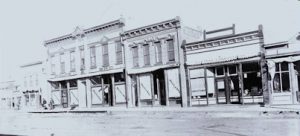
But wait! There’s more good news! The Nebraska Library Commission manages Nebraska Memories, an online archive of digital Nebraska-related historical and cultural heritage materials. Funded through a combination of funding from the Institute of Museum and Library Services and the Nebraska Library Commission, Nebraska Memories contains images digitized from photographs, negatives, postcards, maps, lantern slides, books and other materials. Working either independently or with a partner, Nebraska cultural institutions have digitized and contributed more than 5,000 items to Nebraska Memories.
Libraries and other institutions that have partnered to digitize and upload materials to Nebraska Memories include the Antelope County Historical Society and Tilden’s Raymond A. Whitwer Memorial Library; the Crawford Historical Society and Museum and the Crawford Public Library and the High Plains Historical Society and Museum and the McCook Public Library.
I hope after reading this post, you’ll find the prospect of a digital preservation project less overwhelming. Also, you might decide to reach out to a local historical society or museum in order to host a program or two on local history. If your institution is interested in participating in Nebraska Memories, see http://nlc.nebraska.gov/nebraskamemories/participation.aspx for more information, contact Devra Dragos, Technology & Access Services Director.
Posted in Nebraska Memories
1 Comment
Friday Reads: The Handmaid’s Tale
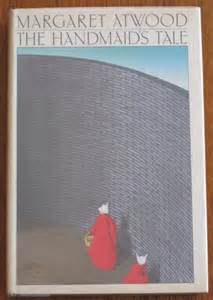 Many of the books I read are populated by strong female characters. Biography, science fiction, literature, mystery – all feature intelligent, feisty and powerful women. Margaret Atwood’s The Handmaid’s Tale is no exception.
Many of the books I read are populated by strong female characters. Biography, science fiction, literature, mystery – all feature intelligent, feisty and powerful women. Margaret Atwood’s The Handmaid’s Tale is no exception.
Set at an unknown point in time, The Handmaid’s Tale is the story of a woman named Offred. The story alternates between Offred’s current day-to-day existence and her memories of a past life. One with a daughter, a loving husband, and a fulfilling career. Now, Offred is valued more for her functioning ovaries than her intelligence.
Offred’s life shifted drastically because the United States no longer exists. In response to declining birth rates and civil unrest, a group of fundamental Christian militants overthrow the government. The Republic of Gilead, as this country is known, institutes a rigid social hierarchy and enacts laws inspired by the Old Testament. Young and healthy women, like Offred, are classified as handmaids and assigned to the homes of childless high-ranking government officials and their wives. Their job is to bear these men’s children.
Although the Republic of Gilead has stripped Offred of her rights, she refuses to give up. She finds ways to assert her independence by swinging her hips while walking or through unsanctioned interactions with men. Often, Offred risks her limited freedom by looking for people who may be able to help her escape from Gilead. Offred reminds us that rebellion doesn’t have to be loud. It can be quiet and slow-burning and still succeed in the end.
The Handmaid’s Tale is currently airing as a series on Hulu.
Atwood, Margaret. The Handmaid’s Tale. New York: Anchor Books, 1986.
The Boys of Summer
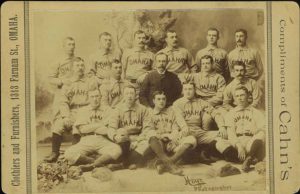 Nothing says summer more than grilled hot dogs, cold lemonade and baseball. Yes, baseball, that most American of past times. Brought to the United States by British immigrants during the eighteenth century, the game as we know it, evolved throughout the nineteenth century. While smaller leagues sprang up around the country, professional leagues didn’t take root until the 1870s.
Nothing says summer more than grilled hot dogs, cold lemonade and baseball. Yes, baseball, that most American of past times. Brought to the United States by British immigrants during the eighteenth century, the game as we know it, evolved throughout the nineteenth century. While smaller leagues sprang up around the country, professional leagues didn’t take root until the 1870s. 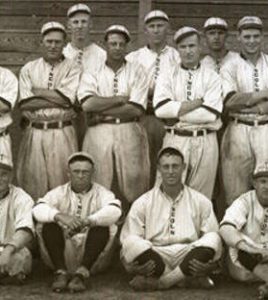
Like other areas, Nebraska colleges and towns fielded baseball teams. In fact, the state has been home to numerous minor league teams. During the first half of the twentieth-century, Lincoln’s Baseball Club was a member of the Western League, which also included a team from Omaha.
To see more photographs of Nebraska baseball teams, visit Nebraska Memories to search for or browse through many more historical images digitized from photographs, negatives, postcards, maps, lantern slides, books and other materials.
Nebraska Memories is a cooperative project to digitize Nebraska-related historical and cultural heritage materials and make them available to researchers of all ages via the Internet. Nebraska Memories is brought to you by the Nebraska Library Commission. If your institution is interested in participating in Nebraska Memories, see http://nlc.nebraska.gov/nebraskamemories/participation.aspxfor more information, contact Devra Dragos, Technology & Access Services Director.
Posted in Nebraska Memories
Leave a comment
Just a Brief Note . . . .
Before I became a librarian, I worked as a researcher for a consulting firm. Most of my work focused on clients who were involved in environmentally-based litigation. While I mainly read typed or printed government records, occasionally a client asked me to look at older documents – shipping manifests, diaries and correspondence – stuff that was written in longhand! As you can imagine, I became proficient at reading nineteenth-century handwriting. Recently, I had a chance to put those skills to the test when a postcard written in German crossed my desk.
For the record, I cannot read or speak German. Before I asked a retired professor from Nebraska Wesleyan to translate, I attempted to do so using Google Translate. I realized pretty quickly the handwriting was not the nineteenth-century script I had dealt with previously. For starters, it may incorporate both German and English cursive.
The script appears to an older form of German-language handwriting known as Kurrent. Kurrent is based on late medieval cursive and German cursive. It was used heavily in Middle to High German-speaking regions during the nineteenth and early-twentieth centuries. Like any written script, Kurrent characters vary in shape and form, making it difficult to interpret.
This particular letter was written to a young woman, named Ella, by her grandmother. In the letter, Ella’s “Granny” mentions two people known to Ella, who had taught at Scribner High School. Although brief, Granny shares some family history, as well as let Ella know that she’s not far from her thoughts.
This letter also tells us that Ella reads, and most likely speaks German. Based on the fact that Kurrent was used in specific places, we have an idea of where Granny lived before moving to Nebraska. Additionally, Scribner wasn’t settled until the 1870s, when the railroad arrived. The high school featured in this image, wasn’t built until 1885. Granny most likely was a relatively recent arrival in eastern Nebraska.
Brief notes like this one can share a lot of information. They drop hints about the writer’s and the reader’s backgrounds and relationships. Postcards offer us a glimpse into the private worlds of people like Granny and Ella.
Visit Nebraska Memories to search for or browse through many more historical images digitized from photographs, negatives, postcards, maps, lantern slides, books and other materials.
Nebraska Memories is a cooperative project to digitize Nebraska-related historical and cultural heritage materials and make them available to researchers of all ages via the Internet. Nebraska Memories is brought to you by the Nebraska Library Commission. If your institution is interested in participating in Nebraska Memories, see http://nlc.nebraska.gov/nebraskamemories/participation.aspx.For more information, contact Devra Dragos, Technology & Access Services Director.
Posted in Nebraska Memories
2 Comments
Good Times in Nebraska
When people think of places like Nebraska, and the American West in general, they often assume that residents have little to no access to cultural institutions. That is, no libraries, opera houses, theaters, art museums or symphonies. Those of us who live in the West, know this to be otherwise. In fact, nineteenth century mining communities hosted traveling acting troupe or minstrel shows. Other early towns built opera houses and theaters, while some opened small libraries.
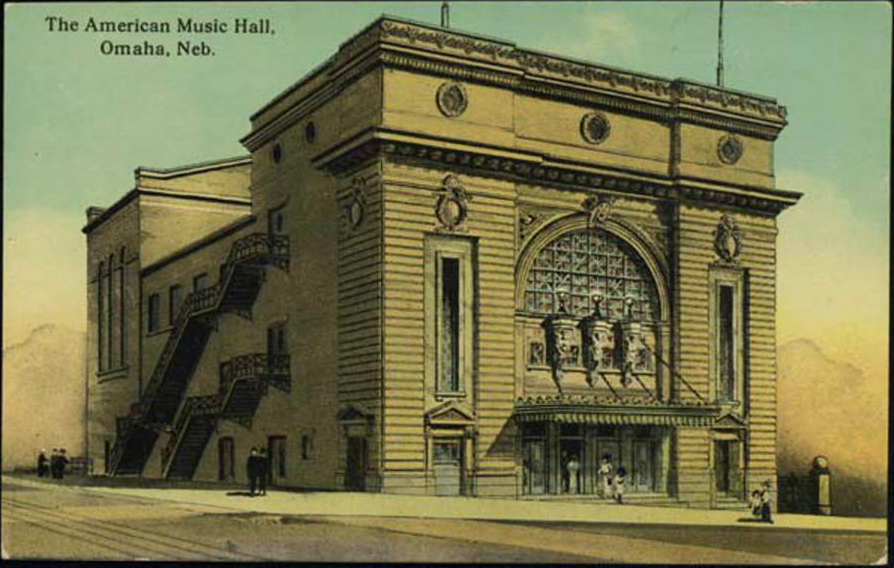
With its large population, Omaha was home to numerous theaters, such as the American Music Hall and the Orpheum Theater.
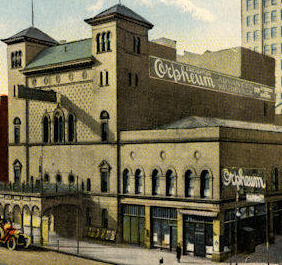
Theaters and other entertainment venues could be found in smaller communities as well. Opera houses, for example, could be found in Valley and Papillion. They may not have been the most beautiful of buildings, but they provided stages for more than a few talented people. More importantly, opera productions allowed people with a brief respite from the rigors of prairie life.
Additionally, Nebraska was home to more than few musical groups. Composed of local musicians, these groups enabled participants to hone their talents while providing entertainment for others. For some musicians, particularly those who immigrated from outside the United States, music may have not only connected them to fellow immigrants, but linked them to their former homes as well.
If the opera or a musical gathering didn’t provide enough entertainment, people could attend Buffalo Bill’s Wild West Show when it roared into the state. Perhaps not high culture, but entertaining!
Visit http://memories.nebraska.gov/ to search for or browse through many more historical images digitized from photographs, negatives, postcards, maps, lantern slides, books and other materials.
Nebraska Memories is a cooperative project to digitize Nebraska-related historical and cultural heritage materials and make them available to researchers of all ages via the Internet. Nebraska Memories is brought to you by the Nebraska Library Commission. If your institution is interested in participating in Nebraska Memories, see http://nlc.nebraska.gov/nebraskamemories/participation.aspx for more information, contact Devra Dragos, Technology & Access Services Director.
Posted in Nebraska Memories
Leave a comment
Friday Reads: The House of the Spirits
I first read Isabel Allende’s The House of the Spirits my junior year of high school. At the time, I was taken with the elements of magical realism that permeated the story. In the twenty years since, I have lost track of the number of times I have read this book. Each time, I gain new insight into this complex, multi-generational novel.

Set in Chile, against the backdrop of social and political upheaval, Allende focuses on the ever-changing fortunes of Esteban Trueba, his wife, Clara del Valle and their children: Blanca, Jaime and Nicolas. While Esteban concentrates on accumulating wealth and power, Clara endeavors to strengthen her clairvoyant talents. Since childhood, Clara has been able to move objects and predict future events, such as the deaths of her older sister and parents. Although Clara cares for her husband, she leads an independent life because she abhors his conservative values. Following their mother’s lead, the children, and later Esteban’s green-haired granddaughter, become swept of up in the socialist revolution and subsequent military coup.
Despite its dark themes, The House of the Spirit is a story of hope and survival. Allende’s characters often experience the worst, but retain an innate sense of right and wrong. Until the bitter end, they continue to believe in the basic goodness of mankind. The last time I read The House of the Spirits, I realized that despite the horrors she had just experienced, Esteban’s granddaughter continues to hope for a better tomorrow. Following her imprisonment, she encounters a woman whose spirit remains strong regardless of efforts to destroy it. Alba, whose name is Spanish for dawn, knows the conservative regime will end and life in Chile will improve for everyone.
Allende, Isabel. The House of the Spirits. Translated by Magda Bogin. New York: Alfred A. Knopf, 1985.
The Joys of Hunting Season in Nebraska
Before the advent of grocery stores, people produced much of their food. Although 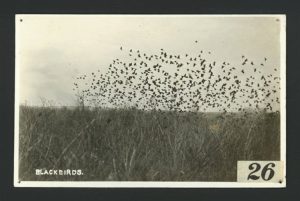 gardens and livestock supplied staples such as vegetables, milk and bacon, many settlers looked to hunting to supplement their diets as well as provide some much needed cash from the sale of pelts. Nebraska Memories not only features postcards and photographs birds and game, but of people posing with their rifles and the fruits of their labors as well.
gardens and livestock supplied staples such as vegetables, milk and bacon, many settlers looked to hunting to supplement their diets as well as provide some much needed cash from the sale of pelts. Nebraska Memories not only features postcards and photographs birds and game, but of people posing with their rifles and the fruits of their labors as well.
While the blackbirds featured in the above image may not have been intended for dinner, you can almost imagine a bird hunter eagerly awaiting their flight so that they might snag a bird or two to add to their collection. Take this photographic postcard from 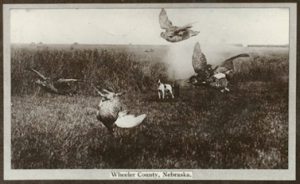 Wheeler County. It shows a hunter, with his trusty hunting dog, firing at several game birds. Chances are, these birds were destined for the family dinner table and the tail feathers used to decorate a hat.
Wheeler County. It shows a hunter, with his trusty hunting dog, firing at several game birds. Chances are, these birds were destined for the family dinner table and the tail feathers used to decorate a hat.
In addition to shooting game birds, Nebraskans hunted other animals, such as coyotes. After 1860, fur traders saw the value of coyote fur pelts increase from almost nothing to a few dollars or more per pelt. Coyote pelts could not be used as rugs, but they could be made into coats, jackets and hats. As such, they most likely became a source of income for many people. 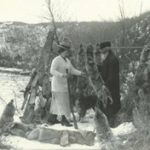 Additionally, ranchers disliked coyotes because they attacked sheep and cows. The couple featured in this postcard may have shot coyotes in order to harvest their fur or they may have been helping ranchers protect their livestock.
Additionally, ranchers disliked coyotes because they attacked sheep and cows. The couple featured in this postcard may have shot coyotes in order to harvest their fur or they may have been helping ranchers protect their livestock. 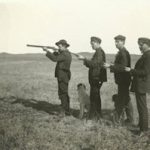
Not all photographs focus on potential targets or an expedition’s results. Some images are of the hunters themselves. This photographic postcard not only features four hunters posing with their shotguns, but three dogs can be glimpsed as well. While two of the three dogs are not visible clearly, the third one sits at his master’s feet, ready for action. Okay, maybe not. But bird hunters relied on dogs such as pointers, spaniels, setters, and retrievers to fetch downed birds. Despite their somewhat casual stances, I do not doubt the abilities of these hunters or their dogs.
Undoubtedly, hunting enabled many families to survive the often harsh and rugged Nebraska plains. A settler with a good shot gun could provide food, warm clothing or bedding in the form of fur pelts and cash from the sale of game or pelts. Hunting also helped protect livestock from predators like coyotes.
Visit Nebraska Memories to search for or browse through many more historical images digitized from photographs, negatives, postcards, maps, lantern slides, books and other materials.
Nebraska Memories is a cooperative project to digitize Nebraska-related historical and cultural heritage materials and make them available to researchers of all ages via the Internet. Nebraska Memories is brought to you by the Nebraska Library Commission. If your institution is interested in participating in Nebraska Memories, see http://nlc.nebraska.gov/nebraskamemories/participation.aspx for more information, contact Dragos Devra Technology & Access Services Director.
Posted in Nebraska Memories
Leave a comment
Friday Reads: The Secret History of Wonder Woman
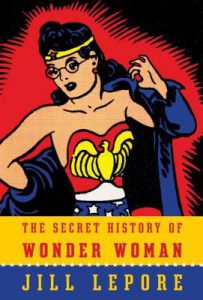 In late October the United Nations celebrated Wonder Woman’s 75th birthday by making her an Honorary Ambassador for the Empowerment of Woman and Girls. You may be wondering how a character, known as much for her “pin-up girl” looks as her crime-fighting skills, achieved such an honor. According to Jill Lepore, author of The Secret History of Wonder Woman (2015), Wonder Woman stands “at the very center of the histories of science, law, and politics.” Lepore argues that the man who conceived of Wonder Woman not only drew from the early-twentieth suffrage and feminist movements, but from his life and “the lives of the women he loved.”
In late October the United Nations celebrated Wonder Woman’s 75th birthday by making her an Honorary Ambassador for the Empowerment of Woman and Girls. You may be wondering how a character, known as much for her “pin-up girl” looks as her crime-fighting skills, achieved such an honor. According to Jill Lepore, author of The Secret History of Wonder Woman (2015), Wonder Woman stands “at the very center of the histories of science, law, and politics.” Lepore argues that the man who conceived of Wonder Woman not only drew from the early-twentieth suffrage and feminist movements, but from his life and “the lives of the women he loved.”
Yep, that’s right. Wonder Woman was created by a man. Not just any man, but William Moulton Marston, the inventor of the lie detector test. Marston was a man of many abilities. In addition to inventing components of the modern polygraph, he also worked as a lawyer, filmmaker and taught psychology prior to becoming a comic book writer. His experiments with lie detection and psychology, in conjunction with a belief in women’s superiority, heavily influenced Wonder Woman’s character. While some of the more suggestive elements later vanished from the strip, Wonder Woman’s feminist message persists.
However, Lepore contends there was more to Marston than met the eye. Unknown except to a few, Marston shared a home with two women: his legal wife and his mistress. Marston married Elizabeth Holloway in 1916. Like Marston, Holloway also held degrees in psychology and the law. Holloway gave birth to two of Marston’s children and worked as an editor and lecturer at American and New York Universities before becoming the assistant to the chief executive at Metropolitan Life Insurance. In the mid-nineteen twenties, Marston became involved with one of his psychology students, Olive Byrne, who also happened to be Margaret Sanger’s niece. Lepore suggests that Holloway allowed Byrne to become Marston’s mistress if Byrne raised Holloway and Marston’s children; permitting Holloway to continue with her career. In time, Marston was the father of Byrne’s two children. The entire family shared a home, with each woman fulfilling her designated role in Marston’s life.
Jill Lepore deftly weaves women’s history through Marston’s biography to create a well-rounded biography of Wonder Woman. A close reading of Wonder Woman comic books reveals many of Marston’s beliefs regarding free love, his complex family life (Wonder Woman’s bracelets are said to honor Byrne who wore a similar pair), patterns of deception and feminist and suffrage themes such as enslavement and bondage. In fact, Lepore argues that “the philosophy of Margaret Sanger’s Woman and the New Race would turn out to be the philosophy of Wonder Woman.” Secret History demonstrates that Wonder Woman is more than skimpy attire and stunning looks, but a pillar of strength and equality – a woman worthy of the title Honorary Ambassador for the Empowerment of Woman and Girls.
Lepore, Jill. The Secret History of Wonder Woman. New York: Vintage Books, 2015.
The Most Wonderful Time of the Year
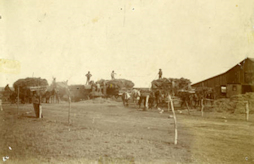 Fall is my favorite time of the year. I love the crisp morning air, the feel of a warm sweater, the tart taste of apple cider on my tongue. For some, however, fall is a sad time. The wheat has been harvested, the trees are bare, and winter is around the corner.
Fall is my favorite time of the year. I love the crisp morning air, the feel of a warm sweater, the tart taste of apple cider on my tongue. For some, however, fall is a sad time. The wheat has been harvested, the trees are bare, and winter is around the corner.
According to the song, “Nebraska in the Fall,” the leaves turn to “red and gold . . . . the flaming sumac flaunts her colors bold and 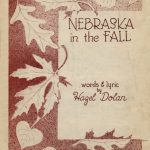 cottonwood and maple have turned to yellow gold!” Having moved to Lincoln in January, this will be my first Nebraska autumn. While I have experienced the cooler mornings, I have yet to see trees dripping with red and orange colored leaves as described by the song’s writer, Hazel Dolan of Louisville.
cottonwood and maple have turned to yellow gold!” Having moved to Lincoln in January, this will be my first Nebraska autumn. While I have experienced the cooler mornings, I have yet to see trees dripping with red and orange colored leaves as described by the song’s writer, Hazel Dolan of Louisville.
However, fall does not invoke images such as those described by Hazel Dolan for all people. In my experience, some see fall as a season of leafless trees and bleak landscapes, like the scene on this postcard of the Pavilion at Omaha’s River Park. 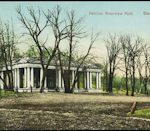 Regardless, many find a way to enjoy the season. This group from Lincoln’s Union College apparently found something to celebrate or at least a way to stay warm!
Regardless, many find a way to enjoy the season. This group from Lincoln’s Union College apparently found something to celebrate or at least a way to stay warm! 
While most of the fall-related images in Nebraska Memories are of leafless trees, there are many other pictures that capture the essence of autumn – crews harvesting hay and other crops, nature scenes and music scores.
Visit Nebraska Memories to search for or browse through many more historical images digitized from photographs, negatives, postcards, maps, lantern slides, books and other materials. Nebraska Memories is a cooperative project to digitize Nebraska-related historical and cultural heritage materials and make them available to researchers of all ages via the Internet. Nebraska Memories is brought to you by the Nebraska Library Commission. If your institution is interested in participating in Nebraska Memories, see http://nlc.nebraska.gov/nebraskamemories/participation.aspx for more information, Devra Dragos, Technology & Access Services Director
Posted in Nebraska Memories
Leave a comment
Plotting the Route: Maps of the Missouri River
The summer I turned ten, my family drove from Montana to northern California to visit my grandparents. My dad put me in charge of plotting our route. This was pre-GPS. I actually had to look at the road atlas. Unfortunately, my dad rejected many of suggestions. I think it had something to do with the fact that some of them would have taken us through North and South Dakota, Wyoming, Utah and Colorado – not exactly the most direct way to travel from Montana to California. Regardless, I found I enjoyed looking at maps. Something I still like to do.
Maps do more than tell us how to get from one place to another. Depending on the map, they can convey information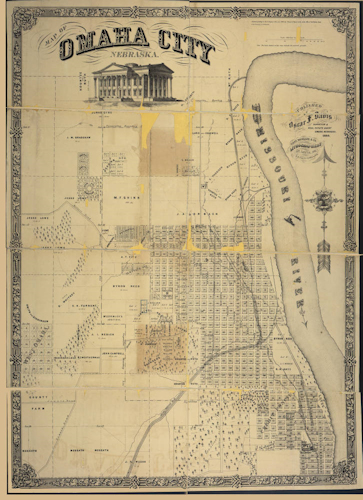 like elevation, land use, socio-economic levels. If they are maps of bodies of water, they mark the locations of navigational hazards, ship wrecks and water depth. In some cases, we can use maps to show how rivers have changed their course over time or the evolution of land use in an area. Nebraska Memories features several maps and an atlas or two.
like elevation, land use, socio-economic levels. If they are maps of bodies of water, they mark the locations of navigational hazards, ship wrecks and water depth. In some cases, we can use maps to show how rivers have changed their course over time or the evolution of land use in an area. Nebraska Memories features several maps and an atlas or two.
Maps depict more than geography. Some focus on the mundane and the ordinary, such as city planning. For example, this map of Omaha from 1866 shows the city laid out in a grid pattern. While the city blocks are numbered, individual owners are not named. With a little help from a Polk Directory and/or the Census, you could figure out who lived where. Regardless, this map provides us with plenty of information — it shows the location of Nebraska’s first capitol building at Twentieth and Dodge Streets. It also tells us the Omaha experienced some flooding during its early years. How do I know? The map marks the locations of several levees along Omaha’s eastern boundary. Also, the cemeteries are located on the western edge of Omaha, far from the Missouri River.
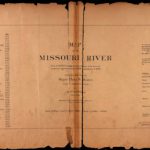 Speaking of the Missouri River, two atlases chart the course of the Missouri River from its mouth to its source in Three Forks, Montana. Both the Map of the Missouri River from its Mouth to Three Forks, Montana and the Map of the Missouri River from surveys made, in accordance with acts of Congress approved June 18, 1878 and March 3, 1879 under the direction of Major Chas. R. Sutter show an amazing amount of detail.
Speaking of the Missouri River, two atlases chart the course of the Missouri River from its mouth to its source in Three Forks, Montana. Both the Map of the Missouri River from its Mouth to Three Forks, Montana and the Map of the Missouri River from surveys made, in accordance with acts of Congress approved June 18, 1878 and March 3, 1879 under the direction of Major Chas. R. Sutter show an amazing amount of detail.
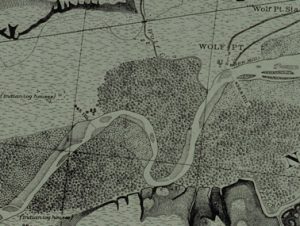 These maps plot the locations of islands, sandbars, vegetation, the locations of previous channels and much, much more. The Map of the Missouri River from its Mouth to Three Forks, Montana also notes Indian settlements, wood yards, and large ranches. Since the maps are drawn as though you are looking at them from above, it’s like looking at the nineteenth-century version of a Google map.
These maps plot the locations of islands, sandbars, vegetation, the locations of previous channels and much, much more. The Map of the Missouri River from its Mouth to Three Forks, Montana also notes Indian settlements, wood yards, and large ranches. Since the maps are drawn as though you are looking at them from above, it’s like looking at the nineteenth-century version of a Google map.
Maps, like old photographs and postcards allow us to travel into the past. We not only see how rivers have changed course or how cities have evolved, we catch a glimpse of what mattered to the mapmakers. Since the Missouri River was a major transportation route, these mapmakers were focused on documenting navigational hazards, woodlots, and Indian settlements. They wanted to ensure that riverboats would be able to navigate safely, as well as resupply as necessary. Looking back on that long ago road trip to California, the maps we used may not have contained the same sorts of information as the ones found within Nebraska Memories, but they provided us with the information we needed.
Visit Nebraska Memories to search for or browse through many more historical images digitized from photographs, negatives, postcards, maps, lantern slides, books and other materials.
Nebraska Memories is a cooperative project to digitize Nebraska-related historical and cultural heritage materials and make them available to researchers of all ages via the Internet. Nebraska Memories is brought to you by the Nebraska Library Commission. If your institution is interested in participating in Nebraska Memories, see http://nlc.nebraska.gov/nebraskamemories/participation.aspx for more information, contact Devra Dragos, Technology & Access Services Director.
Posted in Nebraska Memories
Leave a comment
Friday Reads: The Passage Trilogy by Justin Cronin
In 2010 Justin Cronin published The Passage, the first book in The Passage Trilogy. Set roughly 100 years after the accidental release of thirteen vampire-like test subjects (virals), The Passage focuses on one of the few remaining human settlements. After their release from a government facility, the virals killed or infected the majority of Americans, leaving few behind. With their food supply and power resources dwindling, a small band sets out in search of other survivors. They also seek the story of a mysterious young girl, Amy, who is not what she seems. Led by a young man named Peter, they find some answers.
The subsequent novels, The Twelve (2012) and The City of Mirrors (2016), follow Peter’s three decade journey to defeat the virals, as well as discover the truth about Amy. During this period, it appears as though the virals have been destroyed. Their disappearance results in the population spreading beyond their walled settlements. However, not all is as it seems. Unbeknownst to Peter and his allies, the virals are massing for a series of attacks. The City of Mirrors focuses on these battles, as well as a herculean attempt to save the remaining survivors.
While The Passage Trilogy serves as a classic example of post-apocalyptic fiction, Cronin draws from works such as the Bible and Bram Stoker’s Dracula to create a nuanced and multi-layered story. His characters are more than words on a page, but living, breathing human beings. It would have been easy for Cronin to rely on stereotypes such as the damsel in distress, the classic loner or the all-conquering hero. These are not perfect people, but deeply flawed and damaged individuals, who, for whatever reason, refuse to give up hope. Rather, Cronin explores their faults – how these weaknesses enable them to survive and even grow. Despite their faults, or perhaps because of them, characters such as Peter are likeable. Ultimately, this story centers on relationships and what ties us together as a society, as a race.
Cronin is an excellent writer, with a fluid and relatable style of writing. Unlike similar trilogies, the story does not get bogged down in the details. Additionally, there are no slow parts, where the story stops moving. Even when there is little action, Cronin continues to move the story forward. Each time I read his books, I feel like I am reading them for the first time. Often, they give me the chills and I have to stop reading. If you are a fan of vampires and post-apocalyptic fiction, then I highly recommend this series.
Cronin, Justin. The Passage. New York: Ballantine Books, 2010. Print.
Cronin, Justin. The Twelve. New York: Ballantine Books, 2012. Print.
Cronin, Justin. The City of Mirrors. New York: Ballantine Books, 2016. Print.
Here Comes the Bride!
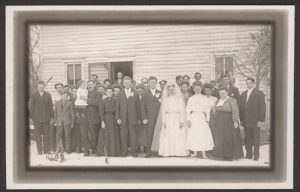 June is the month for weddings. In Western culture, the tradition of marrying in June dates from Roman times, when early Romans celebrated the festival of Juno, the goddess of marriage and childbirth, on June first. As such, couples considered June to be a good time to marry. During the Victorian Era, weddings were held in June because of the availability of flowers. Some claim that because many people bathed only once a year, usually in the spring, brides chose June because they and their guests were still relatively clean. In the modern era, brides and grooms may select June for other reasons. Or they may choose not to wed in June, but at a time more convenient for them.
June is the month for weddings. In Western culture, the tradition of marrying in June dates from Roman times, when early Romans celebrated the festival of Juno, the goddess of marriage and childbirth, on June first. As such, couples considered June to be a good time to marry. During the Victorian Era, weddings were held in June because of the availability of flowers. Some claim that because many people bathed only once a year, usually in the spring, brides chose June because they and their guests were still relatively clean. In the modern era, brides and grooms may select June for other reasons. Or they may choose not to wed in June, but at a time more convenient for them.
Interestingly, it appears that of the couples appearing in Nebraska Memories, many chose not to marry in June. According to the dates on the photographs, these couples wedded in months other than June. Or at least the photographs were not taken in June. So perhaps June was not a popular time for couples to wed in Nebraska. Unfortunately, we don’t know why couples chose their wedding dates. For some, it simply may have made more sense to marry in the dead of winter than to wait for warm summer days.
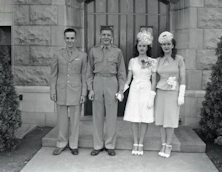 Having grown up among farmers and ranchers, where weddings were often squeezed in between planting and harvesting, haying or even hunting season, I think some couples wedded when they and their families had a free moment! In same cases, it appears couples married before the groom had to report to base or ship off to war.
Having grown up among farmers and ranchers, where weddings were often squeezed in between planting and harvesting, haying or even hunting season, I think some couples wedded when they and their families had a free moment! In same cases, it appears couples married before the groom had to report to base or ship off to war.
Looking through Nebraska Memories, I found a variety of wedding-related 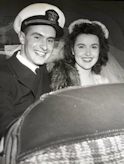 photographs. For the most part, they are of brides and grooms, wedding venues and wedding parties. Many are studio portraits of brides and grooms, but a few are less formal. No, not the candid shots that we’re used to seeing of brides feeding cake to their grooms or children dancing! But smiling and relaxed couples, standing with friends or sitting in their cars.
photographs. For the most part, they are of brides and grooms, wedding venues and wedding parties. Many are studio portraits of brides and grooms, but a few are less formal. No, not the candid shots that we’re used to seeing of brides feeding cake to their grooms or children dancing! But smiling and relaxed couples, standing with friends or sitting in their cars.
While we don’t know the fate of the couples featured in this post, we do know what happened to one: Ben and Katherine Homan of David City, Nebraska, who married on November 22, 1901. According to the notes attached to this photograph, they raised nine children and operated Homan Appliance store. A colleague did some digging and discovered they had many grandchildren and great-grandchildren. 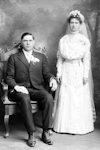
Visit Nebraska Memories to search for or browse through many more historical images digitized from photographs, negatives, postcards, maps, lantern slides, books and other materials.
Nebraska Memories is a cooperative project to digitize Nebraska-related historical and cultural heritage materials and make them available to researchers of all ages via the Internet. Nebraska Memories is brought to you by the Nebraska Library Commission. If your institution is interested in participating in Nebraska Memories, see for more information, contact Devra Dragos Technology & Access Services Director.
Posted in General, Nebraska Memories
Leave a comment
Trees, Trees and More Trees!
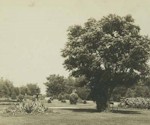 Since moving to Nebraska I have discovered many new and interesting facts. For example, Nebraska was the first state admitted to the United States after the Civil War. Nebraska is also home to both the National Museum of Roller Skating and the International Quilt Center and Museum. It’s also the site of the first American commemoration of Arbor Day. According to the Arbor Day Foundation, Arbor Day was first celebrated in 1872, in Nebraska City.
Since moving to Nebraska I have discovered many new and interesting facts. For example, Nebraska was the first state admitted to the United States after the Civil War. Nebraska is also home to both the National Museum of Roller Skating and the International Quilt Center and Museum. It’s also the site of the first American commemoration of Arbor Day. According to the Arbor Day Foundation, Arbor Day was first celebrated in 1872, in Nebraska City.
While J. Sterling Morton, who the Arbor Day Foundation credits with organizing that first Arbor Day, is not included in Nebraska Memories, there are many tree-filled photographs and postcards. Browsing through the collection, it seems as though trees pop up everywhere – in front of churches, libraries, schools, government buildings, and private homes. Trees even stand adjacent to Nebraska’s legendary cornfields!
In many of the images, the trees appear to have been deliberately planted. That is, I didn’t see a lot of pictures of broad forests, similar to those found in western Montana. For 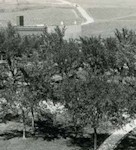 example, the trees surrounding Green Terrace Hall, on the campus of the Nebraska State Normal School in Kearney, grow in neat rows. This does not hold true for all the photographs and postcards I found. A postcard featuring two young women in Omaha’s Hanscom Park, depicts a meadow crowded with trees; while a postcard of Big Saddle Butte, near Crawford, shows trees scattered around a butte.
example, the trees surrounding Green Terrace Hall, on the campus of the Nebraska State Normal School in Kearney, grow in neat rows. This does not hold true for all the photographs and postcards I found. A postcard featuring two young women in Omaha’s Hanscom Park, depicts a meadow crowded with trees; while a postcard of Big Saddle Butte, near Crawford, shows trees scattered around a butte.
I’m sure in the coming months and years, I’ll learn many more fascinating bits of trivia. Here’s one more: Arbor Day is the last Friday of April. You don’t need to plant a tree to celebrate, but take a moment to enjoy the beauty of a tree. 
Visit Nebraska Memories to search for or browse through many more historical images digitized from photographs, negatives, postcards, maps, lantern slides, books and other materials.
Nebraska Memories is a cooperative project to digitize Nebraska-related historical and cultural heritage materials and make them available to researchers of all ages via the Internet. Nebraska Memories is brought to you by the Nebraska Library Commission. If your institution is interested in participating in Nebraska Memories, see http://nlc.nebraska.gov/nebraskamemories/participation.aspx for more information, contact Devra Dragos, Technology & Access Services Director.
Posted in Nebraska Memories
Leave a comment
Windmills of Nebraska
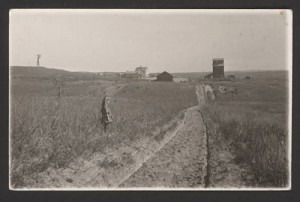 In early January, I moved from Montana to Nebraska. This is not necessarily the best time of the year for a road trip. It’s cold. It’s bleak. Fortunately, my mom decided to make the trip with me. We entertained ourselves by talking about the landmarks, odd formations, and abandoned structures we glimpsed along the freeway. For example, as we drove from Scottsbluff to Lincoln, we saw a lot of windmills. It seemed like there were windmills popping up all over the place. Looking for windmills helps make that last leg go a little faster!
In early January, I moved from Montana to Nebraska. This is not necessarily the best time of the year for a road trip. It’s cold. It’s bleak. Fortunately, my mom decided to make the trip with me. We entertained ourselves by talking about the landmarks, odd formations, and abandoned structures we glimpsed along the freeway. For example, as we drove from Scottsbluff to Lincoln, we saw a lot of windmills. It seemed like there were windmills popping up all over the place. Looking for windmills helps make that last leg go a little faster!
Now, we have windmills in Montana. We even have a few wind farms, but you do not see a lot of windmills standing alone in a field. Most are adjacent to a farmhouse or a barn, and may still be operational. For those living off the grid, windmills serve as an excellent power source. Wanting to see 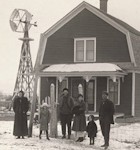 more of Nebraska’s windmill heritage, I searched Nebraska Memories for images and publications.
more of Nebraska’s windmill heritage, I searched Nebraska Memories for images and publications.
As you may know, homesteaders used windmills to convert wind into energy that could be used to pump water wells. In areas where there are few rivers, it makes sense that farmers and ranchers used the energy generated by windmills to bring water to the surface. Looking through Nebraska Memories, I found a few photographs of windmills. However, rather than featuring a solitary windmill in a field, most of the images depicted windmills standing adjacent to a homestead or lurking in the background. This makes sense. After all, the windmills my mom and I glimpsed as we sped across the Nebraska plains were the remains of abandoned homesteads.
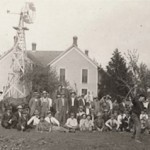 If you would like to see more photographs of windmills, visit Nebraska Memories to search for or browse through many more historical images digitized from photographs, negatives, postcards, maps, lantern slides, books and other materials.
If you would like to see more photographs of windmills, visit Nebraska Memories to search for or browse through many more historical images digitized from photographs, negatives, postcards, maps, lantern slides, books and other materials.
Nebraska Memories is a cooperative project to digitize Nebraska-related historical and cultural heritage materials and make them available to researchers of all ages via the Internet. Nebraska Memories is brought to you by the Nebraska Library Commission. If your institution is interested in participating in Nebraska Memories, http://nlc.nebraska.gov/nebraskamemories/participation.aspx For more information, contact Devra Dragos, Technology & Access Services Director.
Posted in Nebraska Memories
Leave a comment

